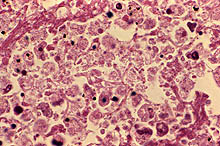Legionnaire’s Disease: Symptoms
and Causes
Legionnaire’s disease acquired its name in July 1976 when an outbreak of pneumonia occurred among people attending a convention of the American Legion at the Bellevue-Stratford Hotel in Philadelphia.
On January 18, 1977 the causative agent was identified as a previously unknown
bacterium, subsequently named Legionella. Some people can be infected with the
Legionella bacterium and have only mild symptoms or no illness at all.
SYMPTOMS:

Lung tissue specimen from a patient with fatal pneumonia due to Legionnaire's disease.
|
It initially appears to be the flu. There is headache, fatigue, achiness, and moderate fever. But then it develops into what seems more like pneumonia: a high fever (105°F) with coughing, diarrhea, chills, disorientation, slow heart rate, and dry cough, infection of the pleura, vomiting, severe chest pain, and shortness of breath. From lack of oxygen, the skin becomes bluish. The sputum that is coughed up eventually is gray or blood-streaked.
CAUSES:
The bacteria that cause Legionnaire's disease have been found in water delivery systems. They can survive in the warm, moist, air conditioning systems of large buildings, including hospitals.
Most cases are caused by Legionella pneumophila. The rest of the cases are caused by other Legionella species.
Spread of the bacteria from person to person has not been proven.
Most infections occur in middle-aged or older people, although they have been reported in children. Typically, the disease is less severe in children.
|